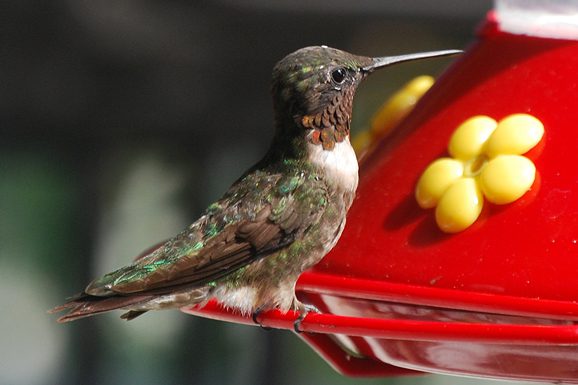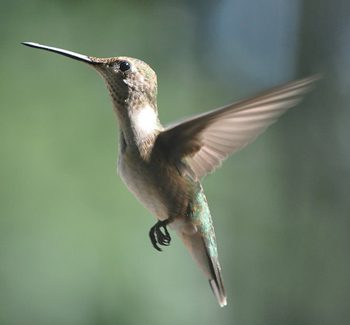Hum’s the word

One of my fondest childhood memories is sitting on the front porch of my grandparents’ house, gentle breeze blowing, sweet tea in hand, listening to the buzz and flight of hummingbirds as they gracefully sipped sugar water from bright red feeders. Sometimes there’d be more than a dozen of them, dancing acrobatically in the air, chasing one another, dipping and diving, backwards and forwards – almost like tiny ballerinas in the air.
Hummingbirds are remarkable. Their wings are one reason – and perhaps it is fitting that their name is thought to have originated as a result of the humming noise their beating wings create. They can fly at speeds greater than 30 miles per hour and are the only species of bird that can fly backwards. How they fly has been studied in wind tunnels. Their acrobatic feats are thought to be possible because of a special muscle-bone arrangement and wing movements in an efficient figure-eight pattern. The typical speed of their wing beats ranges from 12 to 80 times per second, with an average of around 50 per second. They can also hover in mid-air by rapidly flapping their wings, in which case they can go as high as 200 wing beats per second.
This amazing wing speed does come at a cost. Hummingbirds expend so much energy during rapid flight that they are often only hours away from starving to death. They can consume their entire body weight in nectar daily, even though they spend much of their time perched and resting. Hummingbirds also supplement their diet with protein in the form of spiders and insects. In spite of consuming so much food, they usually have just enough energy to survive overnight, so they slow their heart rate down and go into “torpor” – a sort of temporary hibernation – where their heart beat slows to only 50 beats per minute. For perspective, during intense flight their heart rate can get as high as 1,260 beats per minute.
 There are approximately 330 species of hummingbird, all found in the western hemisphere. There are some fossil records of hummingbirds that have been found in Europe, but none exist there today. The ruby-throated hummingbird is the only hummingbird that breeds in the eastern United States, and they migrate south starting in late summer. Other species of hummingbird from northern areas migrate through our area well into October. Many species migrate from Canada and the U.S. to Mexico or Central America to winter. Until recently, it was rare to spot hummingbirds in the winter, and such birds have been termed “rogue hummingbirds.” Since 1999, the N.C. Museum of Natural Sciences has been investigating these winter occurrences of vagrant hummingbirds that either don’t migrate south or are spotted outside of their normal range. If you want report a sighting you can do so at www.naturalsciences.org.
There are approximately 330 species of hummingbird, all found in the western hemisphere. There are some fossil records of hummingbirds that have been found in Europe, but none exist there today. The ruby-throated hummingbird is the only hummingbird that breeds in the eastern United States, and they migrate south starting in late summer. Other species of hummingbird from northern areas migrate through our area well into October. Many species migrate from Canada and the U.S. to Mexico or Central America to winter. Until recently, it was rare to spot hummingbirds in the winter, and such birds have been termed “rogue hummingbirds.” Since 1999, the N.C. Museum of Natural Sciences has been investigating these winter occurrences of vagrant hummingbirds that either don’t migrate south or are spotted outside of their normal range. If you want report a sighting you can do so at www.naturalsciences.org.
The bright red coloration under their necks that gives the ruby-throated hummingbirds their name can change, depending on how they turn. The red color is not from pigmentation, but from prism-like cells within the feathers that reflect light of different wavelengths and intensity. The result is that when a ruby-throated hummingbird moves or shifts from your viewing perspective, the colors can go from dark to vivid red or green.
Although many hummingbirds die within the first year of life, hummingbirds can live as long as 10 years. Only the female nests, in a small cup-shaped nest, where she lays the smallest of all bird eggs.
Hummingbirds are specialized pollinators. The flowers they feed upon are shaped for their bill, and many of the flowers are bright reds, oranges and pinks. Their eyesight allows them to see into the near-ultraviolet range, but the flowers do not reflect those wavelengths. This narrow color spectrum results in flowers that are more inconspicuous to insects like bees, which see more widely into the UV spectrum. I once saw a demonstration where a black light shone on a daisy revealed a sort of bulls-eye pattern – a not-so-subtle way of attracting preferred pollinators.
If you would like to encourage hummingbirds in your yard with hummingbird feeders, you can use sugar water. White granulated sugar is the best, and a preferred recipe is a mixture of 1 cup sugar to 4 cups water. Boil and cool the mixture before use. As an alternative, you can cultivate many native plants and flowers to attract hummingbirds, including vines like trumpet creeper and yellow jasmine, bee balm, jewelweed, black locust and buckeye. Plant some of these, and soon you’ll be able to sit back and watch these amazing, tiny creatures buzz and hum around your yard.